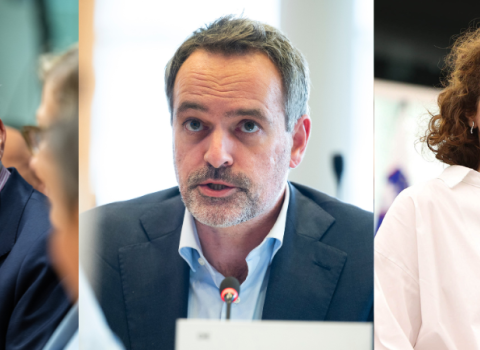Researchers from the Center for Energy, Environmental and Technological Research (CIEMAT) have participated in a decisive European experiment where the mixture of deuterium and tritium (DT) fusion fuel, the one planned for ITER, has been used, reaching the fusion energy record of 59 megajoules, held for 5 seconds. The results of the experiment, announced today, are the clearest demonstration in 25 years of the potential of fusion power to provide safe and sustainable energy with low carbon dioxide emissions.
Specifically, the CIEMAT researchers Elena de la Luna, who has acted as one of the task force leaders of the experimental campaign, and Emilia Rodríguez Solano, scientific coordinator of several experiments, belong to the international group of scientists of the consortium EUROFusion that has participated in the recent experiments carried out in the European device Joint European Torus (JET). This European scientific facility is located in the English town of Oxford and is the largest magnetic confinement fusion facility currently in operation worldwide.
The EUROfusion consortium, co-financed by the European Union, integrates 4,800 experts, students and technical personnel from 28 countries, approximately 140 of them are assigned to the CIEMAT and another 150 to other R&D centers, universities and Spanish industries.
Among these collaborations, it is worth mentioning the participation of the researcher Mervi Mantsinen, ICREA research professor and leader of the Fusion group of the Barcelona Supercomputing Center (BSC).
Mantsinen led several experiments at JET since the first DT experiments took place. In particular, she has led one out of 19 experiments during this campaign, which delved in the role and optimization of plasma heating in DT plasmas. The experiments were prepared with the help of extensive numerical modelling in close collaboration with the modeling task coordinated by Dani Gallart, who is the member of the Fusion Group at BSC.
In 2021, EUROfusion, through the CIEMAT, entrusted BSC to create an Advanced Computing Center to accelerate the development of fusion energy. The BSC EUROfusion - Advanced Computing Hub is directed by Mantisen.
Also noteworthy is the participation of Eleonora Viezzer, from the University of Seville, scientific coordinators of two of the experiments at JET. This new achievement at JET more than doubles the previous fusion energy record of 21.7 megajoules set there in 1997.
This historical milestone obtained in JET is the result of the advances of more than two decades in nuclear fusion research in Europe and contributes to the preparation of the ITER international project, which is one of the pillars of the EUROfusion strategic plan for the development of fusion energy. In a context of mitigating the effects of climate change through the decarbonisation of energy generation, this milestone constitutes a fundamental step in the scientific-technological roadmap for nuclear fusion as a safe, efficient and low-emission means of dealing with to the global energy crisis.
The General Director of the CIEMAT and former Deputy General Director of ITER, Carlos Alejaldre, stated that "it is excellent news, a real experimental validation that we are on the right track for the development of fusion as a source of energy and in addition to tremendous satisfaction for CIEMAT for the important contribution of our researchers to this milestone".
For his part, the director of the National Fusion Laboratory, Carlos Hidalgo, added that “JET's achievements show our ability to shape the future of energy using the scientific method. A great result that illustrates the strength of the integrated program in fusion science and technology in Europe to face the global challenge towards massive, safe and sustainable energy”.
The director general of ITER, Bernand Bigot, explained that "a sustained pulse of deuterium-tritium fusion at this power level, almost on an industrial scale, is a resounding confirmation for all those involved in the global search for fusion. For the ITER project, the JET results give us great confidence that we are on the right track to demonstrate the feasibility of fusion energy.”
EUROfusion CEO Tony Donné said: “This achievement is the result of years of preparation by EUROfusion's team of researchers from across Europe. The record, and more importantly, what we have learned about fusion under these conditions and how it fully confirms our predictions, show that we are on the right track towards a future fusion-powered world. If we can hold the fusion for five seconds, we will be able to do it for five minutes and then for five hours as we expand our operations on future machines." “This is a great moment for each of us and for the entire fusion community. The operational experience we have gained under realistic conditions gives us great confidence for the next phase of experiments at ITER and at the European demonstration plant EU DEMO, which is being designed to put electricity on the grid,” he added.
The head of the Fusion Science department at EUROfusion, Volker Naulin, pointed out that "from EUROfusion we designed this experimental campaign at JET to optimally prepare for the start-up of ITER by investigating the energy processes that will come into play there and to prepare the next generation of researchers in the field of fusion. The experiments confirmed our predictions, which motivates us to do everything possible to ensure the successful operation of ITER on schedule The results support the early decision to build a DEMO European power plant, as fusion is necessary for the long-term decarbonisation of our energy supply.”
This article was first published on 9 February by BSC.





 A unique international forum for public research organisations and companies to connect their external engagement with strategic interests around their R&D system.
A unique international forum for public research organisations and companies to connect their external engagement with strategic interests around their R&D system.